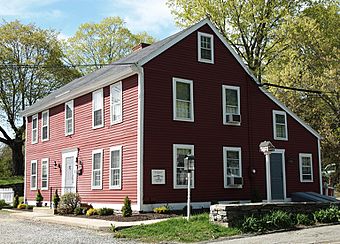Bean Hill Historic District facts for kids
Quick facts for kids |
|
|
Bean Hill Historic District
|
|

The Edmund Goo(d)kin House, built 1738 or earlier
|
|
| Location | Huntington and Vergason Avenues, Sylvia Lane and West Town Street, Norwich, Connecticut |
|---|---|
| Area | 22 acres (8.9 ha) |
| Architect | Multiple |
| Architectural style | Greek Revival, Late Victorian |
| NRHP reference No. | 82001006 |
| Added to NRHP | December 8, 1982 |
The Bean Hill Historic District is a special old neighborhood in Norwich, Connecticut. It was added to the National Register of Historic Places in 1982. This means it's an important place in American history. The district has many old buildings and a green space. These show what life was like in the 1800s when Bean Hill was a busy center for making and selling things.
Contents
What is the Bean Hill Historic District?
This historic area is located near West Town Street in Norwich. It stretches along Huntington Avenue too. The district covers about 22 acres. It includes 23 buildings that are important to its history. These buildings help tell the story of the area.
The Heart of Bean Hill: The Green
The center of the district is the Bean Hill Green. This is a square open space. It is surrounded by Vergason Avenue, Huntington Avenue, and West Town Street. The green was first planned in 1729. It became the main part of a neighborhood where people lived.
Many old buildings face the green. Four of these houses are from the 1700s. There is also the old Bean Hill Methodist Church. It was built in 1833. This was the very first Methodist church in Norwich. The church building has a Greek Revival style. It no longer has its tall steeple. Today, this old church building is used for businesses.
Old Buildings on West Town Street
West Town Street is a major road in western Norwich. In the 1800s, many different houses and businesses lined this street. Some of these old buildings are still standing today.
For example, a building at 204 West Town Street was built around 1870. This building shows what business places looked like in the late 1800s. People believe this spot might have been where the very first house in the area stood.
Images for kids




